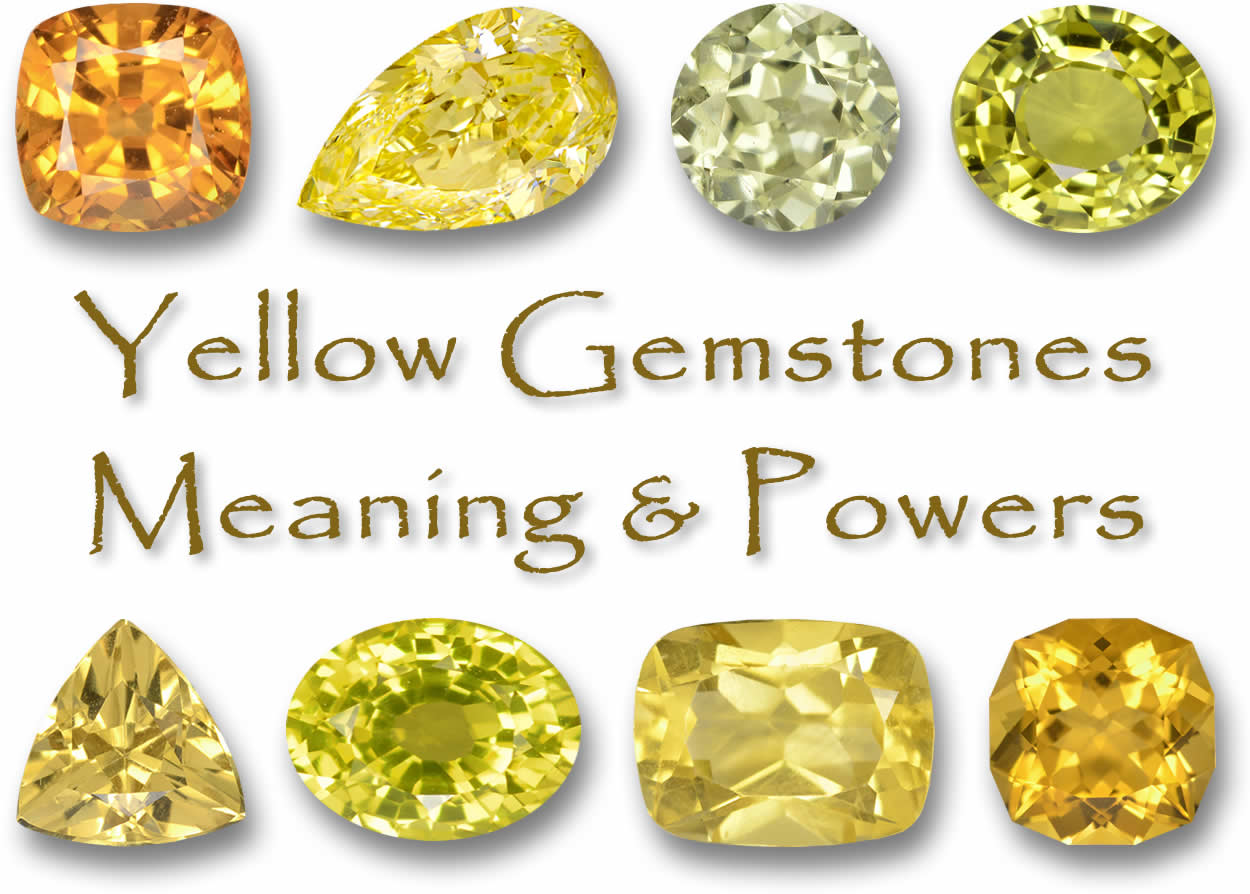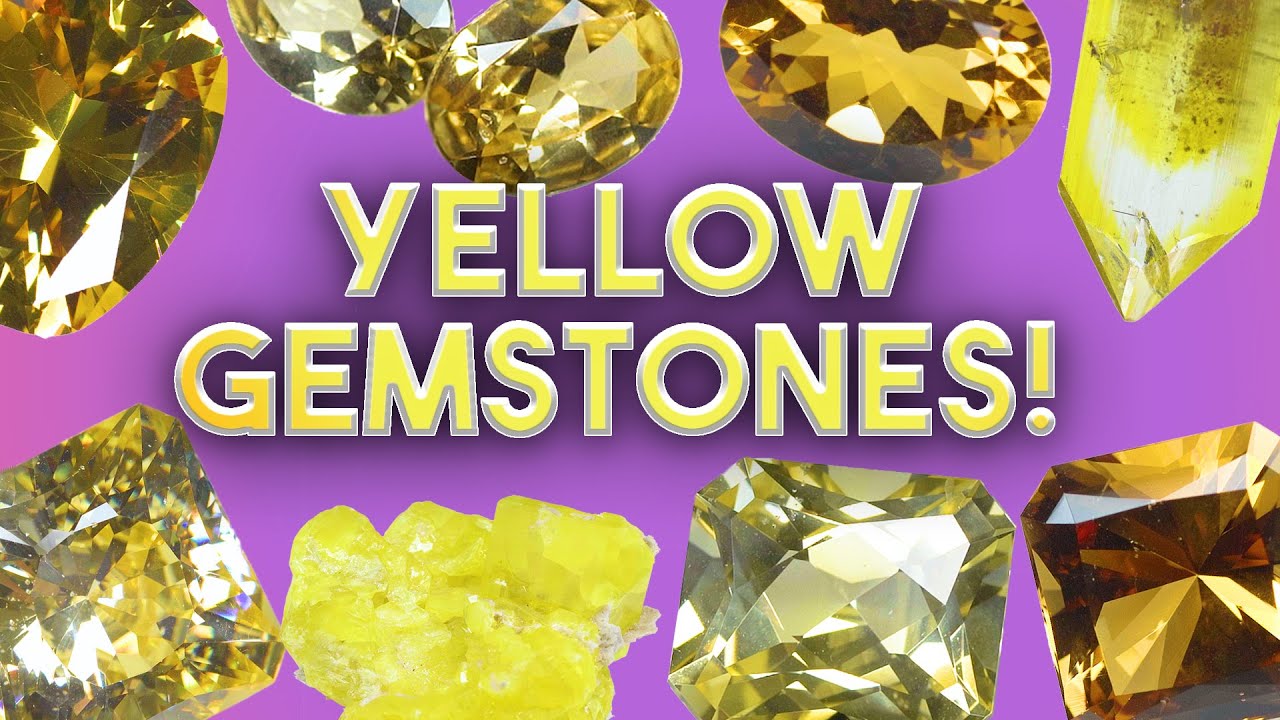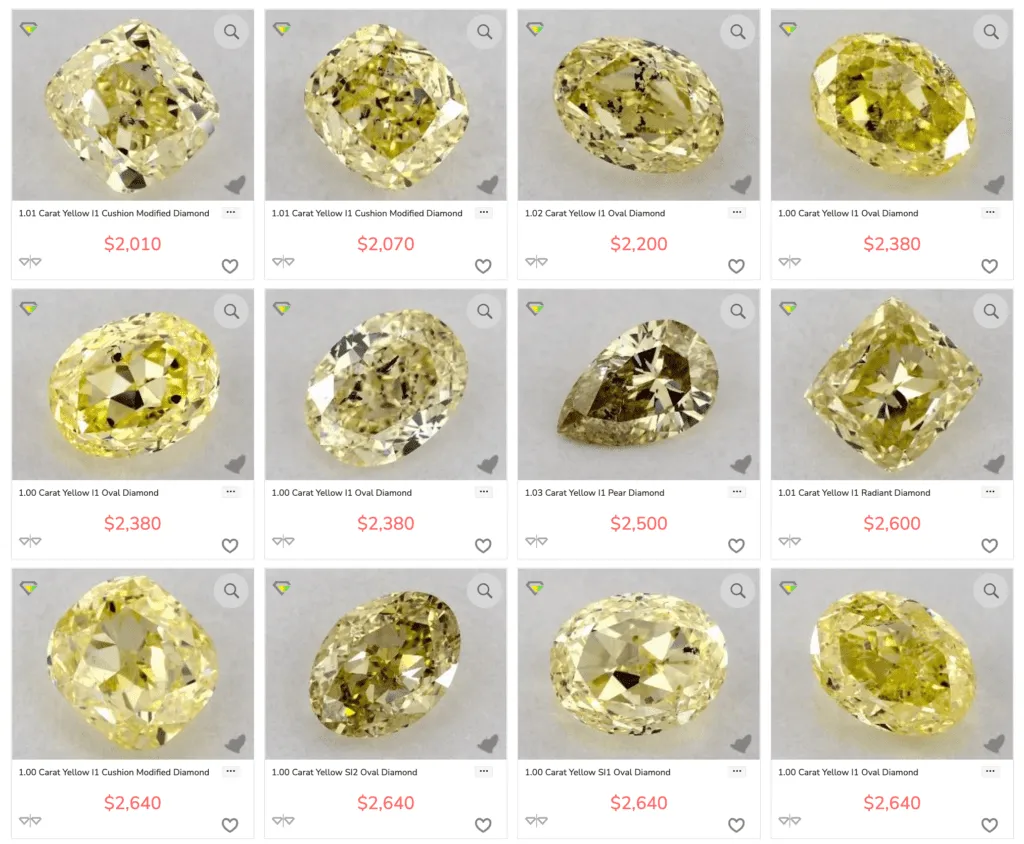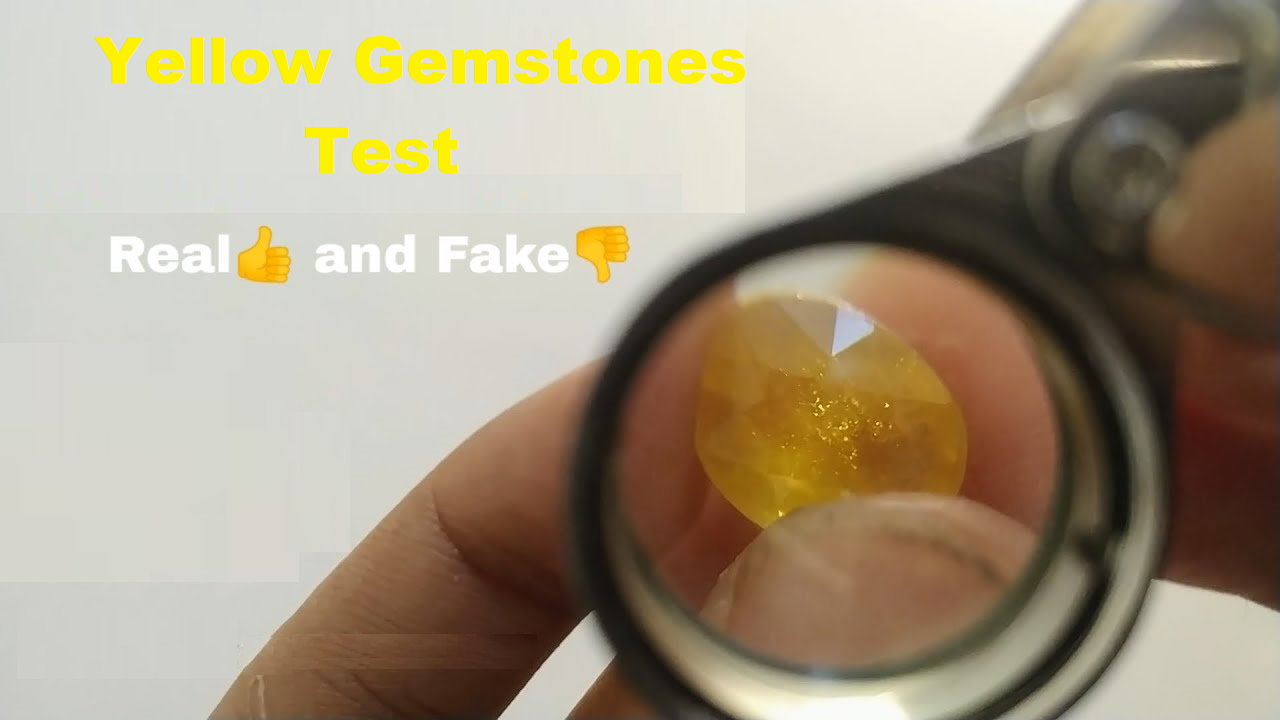
Yellow gemstoneshold an undeniable allure, captivating enthusiasts with their radiant hues and exquisite beauty. Discover How To Tell If A Yellow Gemstone Is Real, from the sunny glow of citrine to the mesmerizing warmth of yellow sapphires, these gems have etched their place in the world of jewelry, adorning pieces with a charm that's both timeless and contemporary.
Distinguishing real yellow gemstones from imitations isn't just a matter of monetary value; it's a journey that safeguards emotional investments. The quest to unravel genuine yellow gemstones from their synthetic twins or clever imitations is essential to preserving the integrity of jewelry collections.
Types Of Yellow Gemstones
The radiant world ofyellow gemstonesoffers a dazzling array of choices, each with its unique charm and character. Let's delve into some of the most popular yellow gems, exploring their captivating beauty and distinctive qualities:
1. Yellow Sapphire
Royalty Radiance -Renowned for its regal elegance, yellow sapphire is a luxurious gemstone prized for its intense yellow hues and exceptional brilliance. Its hardness of 9 on the Mohs scale makes it highly durable, perfect for treasured jewelry pieces.
2. Citrine
Sunshine Gem -Citrine, the November birthstone, embodies the warmth and optimism of sunshine. Its vibrant yellow to orangey-yellow shades and affordability make it a popular choice for jewelry and decorative objects. Citrine is a variety of quartz, with a hardness of 7, making it suitable for everyday wear.
3. Yellow Diamond
Rare Brilliance -Yellow diamonds, also known as "fancy yellows," are exceptionally rare and coveted for their intense color and fire. Their value depends on the depth and purity of their yellow hue, ranging from pale lemon to canary yellow. Yellow diamonds possess the exceptional hardness of 10 on the Mohs scale, making them virtually indestructible.
4. Heliodor
Golden Beryl Bliss -Heliodor, a variety of beryl, showcases a mesmerizing golden-green to pure yellow color. Its vibrant hues and vitreous luster make it a captivating choice for jewelry and collectors' pieces. Heliodor has a hardness of 7.5-8 on the Mohs scale, requiring careful handling.
5. Yellow Topaz
Affordable Allure -Yellow topaz offers a stunning alternative to more expensive yellow gemstones. Its warm yellow to orangey-yellow shades and impressive brilliance make it a versatile and affordable choice for jewelry. Yellow topaz has a hardness of 8 on the Mohs scale, making it suitable for everyday wear.
6. Imperial Topaz
Regal Radiance -Imperial topaz, the rarest and most valuable variety of topaz, boasts a rich orange-yellow to reddish-orange color reminiscent of autumn leaves. Its exceptional fire and brilliance place it among the most coveted gemstones. Imperial topaz has a hardness of 8 on the Mohs scale, requiring careful handling.
7. Chrysoberyl
Chameleon Charm -Chrysoberyl, known for its cat's eye effect, can exhibit a mesmerizing play of light in yellow stones. Its hardness of 8.5 on the Mohs scale makes it a durable choice for jewelry.
8. Yellow Zircon
Sparkling Surprise -Yellow zircon offers remarkable brilliance and fire at an accessible price. Its vibrant yellow hues and wide range of cuts make it a versatile choice for jewelry. Yellow zircon has a hardness of 6.5-7.5 on the Mohs scale, requiring slightly more care than harder gemstones.
This is just a glimpse into the captivating world of yellow gemstones. Each gem possesses its unique personality, waiting to be discovered and cherished. Whether you seek regal elegance, sunny optimism, or dazzling brilliance, there's a perfect yellow gemstone waiting to add a touch of magic to your life.
Visual Inspection Techniques
In the dazzling realm of gemstones, authenticity reigns supreme. When it comes to yellow gemstones, discerning genuine stones from imposters requires a keen eye and a grasp of key visual inspection techniques.
Color Cues
1. Uniformity -True yellow gemstones, like citrine and yellow topaz, typically display consistent color distribution throughout the stone. Be wary of stones with patchy color concentrations or abrupt color variations, as these could indicate treatments or artificial enhancements.
2. Natural Nuances -Natural gemstones often harbor subtle color variations, like zoning (color banding) or pleochroism (color changes from different viewing angles). While these shouldn't significantly impact the overall beauty, their presence can be a reassuring indicator of authenticity.
3. Unnatural Intensities -Some gemstones might be treated to achieve an unnatural intensity or saturation of color. If a yellow stone appears unnaturally vibrant or neon-like, compared to its natural counterparts, it might be a cause for suspicion.
Inclusions & Imperfections
1. Nature's Fingerprints -Natural gemstones rarely exist flawlessly. Tiny inclusions, like mineral flecks or needle-like rutile needles, are common and can even add character to the stone. However, an abundance of large, distracting inclusions or fractures might raise concerns about the stone's durability or authenticity.
2. Clarity Contradictions -If a gemstone boasts exceptional clarity but an unusually intense color, it could be a red flag. Gemstones with enhanced clarity often undergo treatments that might compromise their natural color or durability.
3. Gas Bubbles & Treatment Traces -Gemstones treated with high heat or pressure might exhibit telltale signs, like gas bubbles or fissures filled with glass-like materials. These elements, while not always conclusive, can warrant further investigation.
Other Visual Indicators
1. Cut & Polish -Gemstones with unnatural faceting patterns or uneven polishing might be indicative of synthetic stones or simulants. A well-cut genuine gemstone will exhibit brilliance and sparkle that is often unmatched by imitations.
2. Fluorescence & Phosphorescence -Some gemstones exhibit distinct fluorescence (glowing under ultraviolet light) or phosphorescence (emitting a faint glow after exposure to light). While not a definitive test, observing these properties can provide additional clues about the stone's origin.
3. Seek Expert Advice -When in doubt, consulting a gemologist or reputable jeweler is always the safest bet. Their trained eyes and specialized equipment can provide a conclusive assessment of the gemstone's authenticity and value.
Physical Tests You Can Perform
While definitive gemstoneidentification requires specialized equipment and expert analysis, some simple physical tests can offer clues about your stone's authenticity and properties. However, proceed with caution, as these tests can potentially damage your gemstone if not done carefully.
1. Hardness Test
- What it tells you -Hardness measures a gemstone's resistance to scratching. Different minerals have different hardness levels on the Mohs scale (1-10, with diamond being the hardest).
- The Test -Use a hardness kit containing stones or minerals of known hardness values. Gently scratch your gemstone against a harder mineral on the kit (e.g., quartz against amethyst). If your gemstone scratches the other, it's harder; if it gets scratched, it's softer.
- Caution -This test can leave permanent scratches, so choose an inconspicuous area of the stone and use minimal pressure.
2. Scratch Test (Modified)
- What it tells you -This modified test can help distinguish glass from gemstones.
- The Test -Gently rub your gemstone against a piece of unglazed ceramic tile. If it scratches the tile, it's likely not a gemstone (glass is softer than most gemstones).
- Caution -As above, be gentle and choose a hidden area.
3. Refractive Test
- What it tells you -Refractive index measures how light bends within a gemstone. Different minerals have distinct refractive indices.
- The Test -Place your gemstone on a piece of paper with printed lines. Look through the gemstone at the lines. If the lines appear distorted or broken, it could indicate a specific refractive index range.
- Caution -This test is not highly accurate and requires good eyesight. It's best used for general information rather than definitive identification.
4. Double Refraction Test
- What it tells you -This test identifies birefringent gemstones, which split light into two rays.
- The Test -Hold your gemstone up to a single light source (e.g., phone flashlight) and look through it at a double line pattern (found online or drawn on paper). If the lines appear doubled, your gemstone is likely birefringent.
- Caution -Similar to the refractive test, this is not definitive and requires good lighting and observation skills.
Tips:
- These tests are for informational purposes only and should not be used for making final decisions about your gemstone's value or authenticity.
- Always prioritize the safety of your gemstone over curiosity. If you're unsure about any test, consult a professional gemologist.
- Consider investing in a basic gemological toolkit for more reliable and informative testing at home.
Gemstone Certifications
In the dazzling world of gemstones, trust takes center stage. While their captivating colors and brilliance beckon, ensuring authenticity is crucial. That's where gemstone certifications come in, acting as your trustworthy guide in this glittering terrain.
Unraveling The Significance
Verification of Authenticity -A reputable certificate issued by a recognized gemological laboratory acts as a passport for your gemstone, verifying its species, variety, and treatments (if any). It protects you from fraudulent imitations and ensures you're investing in the genuine article.
Grading Transparency -Certificates delve deeper, meticulously analyzing aspects like color, clarity, cut, and carat weight. This standardized grading system empowers informed decisions, allowing you to compare stones fairly and understand their value with confidence.
Enhanced Resale Value -A certified gemstone is like a story, its journey documented for future reference. This comprehensive report bolsters its value and marketability, making it easier to resell or pass down as an heirloom.
Peace of Mind & Confidence -Investing in a gemstone is a significant decision. A valid certificate brings peace of mind, guaranteeing your purchase aligns with your expectations and budget. Knowing your gem is genuine allows you to fully appreciate its intrinsic beauty and wear it with pride.
Decoding The Certificate
Not all certificates are created equal. Here's what to look for in a reliable one:
Issuing Laboratory -Opt for reports issued by respected and independent gemological institutes like GIA (Gemological Institute of America), GRS (Gemological Research Society), or HRD Antwerp.
Detailed Information -The certificate should clearly state the gemstone species, variety, color, clarity, cut, carat weight, and any treatments undergone.
Transparency & Disclosure -Gemstone enhancements and treatments should be transparently disclosed without ambiguity. This allows you to make informed decisions based on your preferences.
Gemstone Identification Methods -Look for certificates specifying the techniques used for identification, such as refractive index, spectroscopic analysis, or microscopic examination.
Validating Authenticity
Beyond physical details, remember the following pointers:
Gemstone Reference Number -A valid certificate will assign a unique reference number to the gemstone, often laser-inscribed on the girdle (the thin band around the gemstone). This links the report directly to the stone.
Holograms & Security Features -Reputable certificates incorporate security features like holograms or watermarks to prevent counterfeiting.
Physical Verification -Compare the gemstone's physical characteristics, like color and inclusions, with the description on the certificate.
By navigating the world of gemstone certifications with knowledge and awareness, you can unlock the true magic of these radiant treasures, confident in their authenticity and beauty. Remember, a certified gemstone is more than just a sparkle; it's a story waiting to be told, a legacy waiting to be cherished.
Common Tricks Used In Fake Yellow Gemstones
The allure of yellow gemstones, with their radiant hues and captivating brilliance, attracts not only admirers but also those seeking to deceive. Unfortunately, the world of gems can harbor imitations and enhancements, making it crucial to be aware of the tricks employed by the unscrupulous.
Tricky Transformations
- Glass Imitations -Low-cost glass simulants like cubic zirconia (CZ) can be cut and polished to resemble yellow gemstones like citrine or topaz. Look for telltale signs like unnatural color intensity, lack of internal fire or play of light, and brittleness compared to genuine stones.
- Doublets & Triplets -These composite stones consist of a thin layer of genuine yellow gemstone bonded to a colorless base (doublet) or a colored base and colorless crown (triplet). While offering some genuine gem appearance, they lack the depth, brilliance, and durability of a solid stone. Scrutinize the girdle for unevenness or glue lines, and be wary of stones that appear unusually light for their size.
- Dyed Gemstones -Low-quality or colorless gemstones like white quartz or agate can be dyed to mimic yellow hues. Watch for uneven or unnatural color distribution, especially concentrated near fractures or inclusions. Additionally, soaking the stone in warm water might reveal dye bleeding.
Enhanced Enchantment
- Heat Treatment -Some yellow gemstones, like citrine, may be heat-treated to deepen their color or remove unwanted hues. While not necessarily fraudulent, undisclosed heat treatment can affect the stone's value and durability. Ask the seller if the gemstone has undergone any treatments and seek a certificate disclosing such enhancements.
- Diffusion Treatments -Certain gemstones, like topaz, can be diffused with colorants to achieve specific yellow shades. These treatments might be temporary or unstable, affecting the stone's long-term value. Again, transparency about treatments is key.
Spotting The Deception
- Seek Expert Advice -Consulting a reputable gemologist or jeweler for professional assessment is your best bet for definitive identification and verification of treatments.
- Invest in Gemological Tools -A basic gemological toolkit equipped with a loupe, refractometer, and hardness tester can empower you to conduct some preliminary tests at home.
- Embrace Transparency -Ask sellers detailed questions about the gemstone's origin, treatments, and certifications. Look for reputable dealers who offer warranties and certificates from recognized laboratories.
- Trust Your Instincts -If something seems too good to be true, it probably is. If a yellow gemstone appears unnaturally vibrant, suspiciously cheap, or lacks the expected characteristics, exercise caution.
Care And Maintenance Of Yellow Gemstones
Owning a beautiful yellow gemstone is a privilege, bringing a touch of sunshine and sparkle to your life. But just like any treasured possession, these radiant gems require proper care and maintenance to maintain their captivating beauty and intrinsic value.
Gentle Cleansing
- Regular Routine -Clean your yellow gemstone jewelry regularly, ideally after each wear, to remove dirt, oils, and grime that can dull its brilliance.
- Warm & Gentle -Use lukewarm water mixed with a mild, non-abrasive detergent. A gentle dish soap or specialized jewelry cleaner works well. Avoid harsh chemicals, bleach, and ammonia, as they can damage the stone or setting.
- Soft Touch -Use a soft microfiber cloth or clean, lint-free cotton to gently wipe the gemstone. Avoid abrasive materials like paper towels or brushes, which can scratch the surface.
- Ultrasonic Caution -Some yellow gemstones, like citrine and topaz, can be vulnerable to ultrasonic cleaning. Consult a professional cleaner or gemologist if unsure about your specific stone.
Storing With Care
- Separate & Secure -Store your yellow gemstone jewelry in a cool, dry place away from direct sunlight and heat. Invest in a jewelry box with padded compartments to prevent scratches and protect delicate settings.
- Humidity Control -Avoid excessively humid environments, as they can encourage tarnish or damage certain gemstones, like pearls. Silica gel packets can help regulate humidity within your jewelry box.
- Travel Safe -When traveling, pack your gemstone jewelry in a padded pouch or case separately from other pieces to prevent scratches and accidental damage.
Polishing For Perfection
- Professional Touch -Over time, even with proper care, gemstones can lose some of their initial luster. Periodic professional polishing by a qualified jeweler can restore their brilliance and sparkle.
- Home Buffing (Caution!) -For mild dullness, you can try buffing your gemstone with a polishing cloth specifically designed for jewelry. However, proceed with extreme caution and only for hard gemstones like topaz or sapphire. Consult a professional for softer stones or if unsure about the technique.
Remember:
- Prevention is Key -Regular cleaning and gentle handling are the best ways to prevent damage and maintain the value of your yellow gemstone.
- Know Your Stone -Different gemstones have unique cleaning and care requirements. Research your specific stone's needs to ensure proper handling.
- Professional Help -When in doubt, always seek the advice of a qualified gemologist or jeweler for cleaning, repairs, or expert recommendations.
You can ensure your yellow gemstone jewelry thrives for generations, radiating its captivating beauty and holding its intrinsic value. Remember, proper care is the ultimate expression of love and appreciation for these radiant treasures, allowing them to continue dazzling the world with their vibrant glow.


